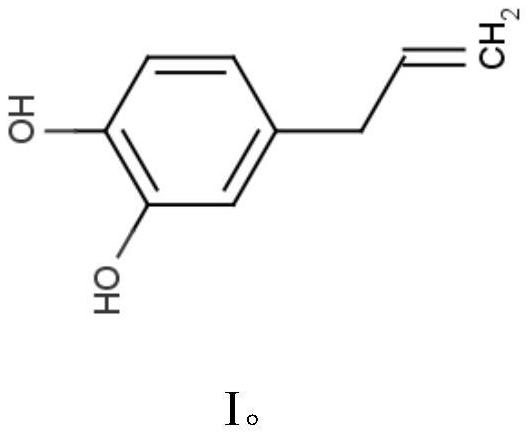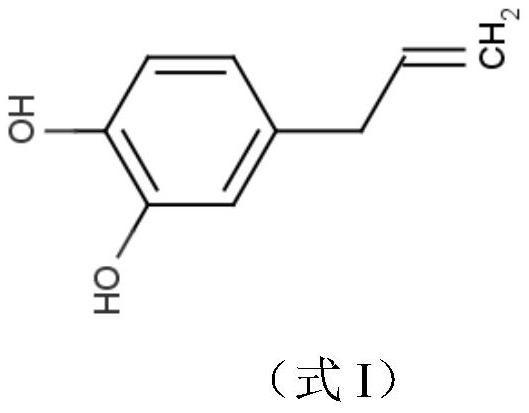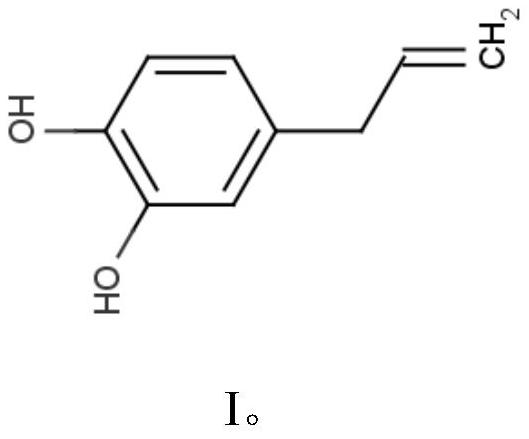Compound for preventing and treating plant pathogenic bacteria and application thereof
A technology of phytopathogenic bacteria and compounds, which is applied in the field of compounds for the prevention and treatment of phytopathogenic bacteria, can solve the problems of no reports on the inhibitory effect of 4-allyl catechol, and achieve good control effects
- Summary
- Abstract
- Description
- Claims
- Application Information
AI Technical Summary
Problems solved by technology
Method used
Image
Examples
Embodiment 1
[0026] Example 1 Preparation and identification of 4-allyl catechol
[0027] The preparation method of 4-allyl catechol comprises the following steps:
[0028] S1: take the branches and leaves of South China pepper and dry them naturally in the shade, then crush them through a 40-mesh sieve to obtain 2 kg of dry powder, and use 95% ethanol solution with a volume concentration (the mass ratio of dry powder to 95% ethanol is 1:10) for the first time. After cold soaking for 7 days, filter, Obtain the first filtrate and filter residue; filter residue continues to use volume concentration 95% ethanol solution for the second time cold leaching extraction (the mass ratio of filter residue and 95% ethanol is 1:10), extracts altogether 3~5 times, until filtrate is colorless, obtains For the second filtrate, the first filtrate and the second filtrate were combined, and the filtrate was concentrated to dryness in a rotary thin film evaporator under reduced pressure to obtain 302.14 g of ...
Embodiment 2
[0039] The difference between this example and embodiment 1 is:
[0040] In step S1, the volume concentration of the ethanol solution is 90%; the time for the first cold soak is 6 days; the mass ratio of the dry powder to the ethanol solution is 1:9; the mass ratio of the filter residue to the ethanol solution is 1:9.
[0041] In step S3, the volume ratio of petroleum ether-ethyl acetate is 3:1;
[0042] In step S4, the volume ratio of petroleum ether-ethyl acetate is 9:1.
[0043] The experimental result of this example is identical with embodiment 1.
Embodiment 3
[0044] Example 3 Determination of the inhibitory activity of 4-allyl catechol to phytopathogenic bacteria
[0045]In the research on the agricultural fungicidal active substances of South China pepper, the inventors found that 4-allyl catechol has a control effect on plant pathogenic bacteria by using the activity tracking method. Take the following experiments as an example to verify the role of 4-allyl catechol in preventing and controlling plant diseases.
[0046] 1. The strains to be tested
[0047] Xanthomonas oryzae, Xanthomonas oryzae, Xanthomonas citri subsp.citri, Acidovorax citrulli, Ralstonia solanacearum Xanthomonas fragariae, Xanthomonas campestris, Xanthomonas campestris, Pectobacterium carotovorum subsp. carotovorum, Pectobacterium carotovorum subsp. brasiliense, Xanthomonas campestris (Xanthomonas compestrispv. mangiferaeindicae). The above strains were all provided by the Pesticide Chemical Biology and Application Research Group of the Institute of Environm...
PUM
 Login to View More
Login to View More Abstract
Description
Claims
Application Information
 Login to View More
Login to View More - R&D
- Intellectual Property
- Life Sciences
- Materials
- Tech Scout
- Unparalleled Data Quality
- Higher Quality Content
- 60% Fewer Hallucinations
Browse by: Latest US Patents, China's latest patents, Technical Efficacy Thesaurus, Application Domain, Technology Topic, Popular Technical Reports.
© 2025 PatSnap. All rights reserved.Legal|Privacy policy|Modern Slavery Act Transparency Statement|Sitemap|About US| Contact US: help@patsnap.com



